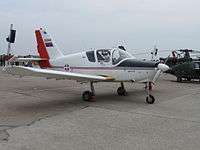UTVA 75
| UTVA 75 | |
|---|---|
 | |
| Slovenian Air Force Utva 75 | |
| Role | Military trainer/general aviation |
| National origin | |
| Manufacturer | UTVA |
| First flight | 19 May 1976[1] |
| Introduction | 1979 |
| Status | active |
| Primary user | Yugoslav Air Force |
| Produced | 1979-1985 |
| Number built | 136[1] |
|
| |
The UTVA 75 is a compact, low-wing monoplane, piston-engine aircraft manufactured by UTVA. It was mainly used as a military basic trainer and sporting aircraft.[2]
Design and development
Designed in 1975 to replace the UTVA Aero 3 as the primary basic trainer in the Yugoslav Air Force. It features upward opening gull-wingtype access doors to the two-seat side-by-side cockpit. Another characteristic is a row of air scoops, presumably for cockpit ventilation, in the central front frame of the cockpit. The Utva 75 made its maiden flight in 1976.[1] Between 1979 and 1985, a total of 136 Utva 75s were produced for the former Yugoslav Air Force.[1] Following the breakup of Yugoslavia, many were passed on to successor states.
Variants
- UTVA 75A11 : Single-seat agricultural aircraft, largely using the Utva 75 airframe.[3]
- UTVA-75A21 : Two-seater with dual controls and provisions for blind instrument flying.[3]
- UTVA-75A41 : Four-seater with advanced avionics, first flown in 1986.[3]
Operators

 Bosnia and Herzegovina - 2 aircraft
Bosnia and Herzegovina - 2 aircraft Croatia - 11 aircraft, replaced in 1998 with Pilatus PC-9 and in 2004 with Zlin Z 242
Croatia - 11 aircraft, replaced in 1998 with Pilatus PC-9 and in 2004 with Zlin Z 242 Macedonia - 4 aircraft, replaced with Zlin Z 242
Macedonia - 4 aircraft, replaced with Zlin Z 242  Montenegro - 3 aircraft
Montenegro - 3 aircraft Serbia - 14 aircraft
Serbia - 14 aircraft  Slovenia - 14 aircraft, replaced with Pilatus PC-9 and Zlin Z 242
Slovenia - 14 aircraft, replaced with Pilatus PC-9 and Zlin Z 242 Sudan - built under license as the Safat 03[4]
Sudan - built under license as the Safat 03[4] Yugoslavia - passed on to successor states.
Yugoslavia - passed on to successor states.
Specifications (UTVA 75A21)
Data from Jane's All the World's Aircraft 1988-89[3]
General characteristics
- Crew: 2
- Capacity: 210 kg (460 lb) max
- Length: 7.11 m (23 ft 4 in)
- Wingspan: 9.73 m (31 ft 11 in)
- Height: 3.15 m (10 ft 4 in)
- Wing area: 14.63 m2 (157.5 sq ft)
- Aspect ratio: 6.5
- Empty weight: 685 kg (1,510 lb) equipped
- Max takeoff weight: 960 kg (2,116 lb)
- Fuel capacity: standard:160 l (42 US gal; 35 imp gal): with drop tanks 360 l (95 US gal; 79 imp gal)
- Powerplant: 1 × Lycoming IO-360-B1F 4-cyl. air-cooled horizontally-opposed piston engine, 134 kW (180 hp)
- Propellers: 2-bladed Hartzell HC-C2YK-1BF/F7666A variable-pitch metal propeller
Performance
- Maximum speed: 215 km/h (134 mph; 116 kn)
- Cruising speed: 165 km/h (103 mph; 89 kn)
- Stall speed: 95 km/h (59 mph; 51 kn) flaps up at idle
- 82 km/h (51 mph; 44 kn) 25° flap at idle
- Range: 800 km (497 mi; 432 nmi)
- Ferry range: 1,080 km (671 mi; 583 nmi)
- Service ceiling: 4,000 m (13,123 ft)
- g limits: +4.4 -2.2
- Rate of climb: 4.5 m/s (890 ft/min)
Armament
- Hardpoints: 2 with a capacity of 100 kg (220 lb) each,
Avionics
optional King KY 195B radio with standard radio compass
See also
| Wikimedia Commons has media related to UTVA-75. |
- Aircraft of comparable role, configuration and era
References
- 1 2 3 4 "Školski avion UTVA-75". Vojska Srbije. Retrieved 10 July 2013.
- ↑ Dusan. "Утва 75". www.vazduhoplovnetradicijesrbije.rs (in Serbian). Belgrade. Retrieved 26 February 2015.
- 1 2 3 4 John W.R. Taylor, ed. (1988). Jane's All the World's Aircraft 1988-89. London: Jane's Information Group. pp. 499–500. ISBN 0-7106-0867-5.
- ↑ "Eurofighter: Dubai Air Show 2011". Eurofighter. 17 November 2011. Retrieved 10 July 2013.